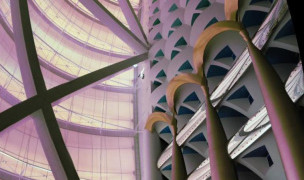 1 Terms
1 TermsHome > Terms > English (EN) > religion
religion
Americans have long been committed to the ideal of religious diversity. Though several of the early European settlements in their beginnings experimented with theocracy— Massachusetts with Congregationalism, Pennsylvania with Quakerism, Maryland and Louisiana with Roman Catholicism—by the end of the seventeenth century the energy for religious uniformity had all but drained away. Many European settlers (e.g. the Puritans and Quakers), who had relocated across an ocean specifically to escape theological conformity were already in a mindset of religious rebellion, and the atmosphere of theological independence inspired new communities (e.g. Rhode Island and Delaware) to break away from original settlements, partly in pursuit of this ideal of consummate religious freedom. White settlers who drifted off to Native American settlements, or who dabbled in the religious beliefs and practices introduced by Africans, also contributed to the widely diverse mixture of religious cultures that had taken root by the time the American Revolution set the United States off on its own course, defined by a 1791 constitutional amendment requiring that the government “make no law respecting an establishment of religion, or prohibiting the free exercise thereof.” The first century of American religion In the decades following the Revolution, the development of religious institutions increasingly followed—and created—social cleavages, along lines of culture, class, region and ethnicity. Though various versions of Christianity were—and remain—the dominant religion in the United States, important Jewish communities developed, and a few Americans, particularly those of North African origin, worshipped in the Islamic tradition as well. Hence, early on, the United States became unique in its conscious and constitutionalized commitment to segregate church from state, to de-politicize religion, to de-religionize politics and to provide “tolerance” for a wide range of religious expression.
Yet, of the diverse traditions which settlers brought to America, almost all have been shaped by just the opposite commitment—by a powerful and prescriptive relationship between religion and the everyday lives of the populace. From Catholic, Anglican, Greek Orthodox, Jewish and, recently Buddhist and Hindu cultures, and numerous smaller groupings, the United States became a merging-point, and a flashpoint, for divergent religious traditions. Religious values therefore remain a persistent, if somewhat ambivalent and subterranean, part of American life in informal as well as formal intersections with politics, education, economics and life choices. As one observer phrased it, “freedom of religion is not freedom from religion.” Over the course of the century following the Revolution, American religions became fragmented as local cultural norms intertwined with religious values and as Americans raised on Puritan traditions worried that religion was dying out in the United States. Early nineteenth-century attempts to reinvigorate what some saw as fading religious energies resulted in what became known as the Second Great Awakening, accompanied by “camp meetings” or “revival meetings” in rural areas, by a phenomenal growth in evangelical and vigorously participatory Protestant religious services and by an increasing alignment between religious affiliations and social, political and/or regional positions. For example, the Southern Baptist denomination, separated from its Northern counterpart by its predominantly rural population and its vigorous support of slavery became the backbone of American slave society. By contrast, Unitarianism and Quakerism came to be distinguished by their small numbers, their concentration in the Northern states and the Ohio Valley and by their devotion to the abolitionist cause. Over time, other denominations became associated with particular political and/or social causes. Northern Baptists were strong in the temperance movement, Catholics sent missionaries among Native Americans, Afri-can Methodist Episcopal (AME) churches supported black schools, Jewish synagogues underwrote urban-settlement houses for new immigrants and Northern Methodists encouraged the Young Men’s Christian Association movement to encourage young men to remain strong in Christian faith. Episcopalianism, with its strong roots in the Anglican church, maintained tradition for the dwindling number of Americans of British ancestry.
Religious practice in modern America American national rituals are almost always nominally religious, broadened in recent years from a vaguely “Christian” tradition to an equally ill-defined “Judaeo-Christian” tradition. Politicians almost always profess a belief in a “higher power,” but are careful not to sound too fundamentalist, too metaphysical, or too extreme. Political officials are installed with a prayer and a Bible as part of the ceremonies, but in the most democratic of institutions—the school—prayer is prohibited lest it appear that there is official proselytizing of any particular religious practice.
Instead of a shared religion, the United States is greatly influenced by what some observers have called “civil religion”—a widespread acceptance of a unifying set of values that bind Americans to a shared code of behavior. While trying to maintain a posture of separation between church and state, Americans have attempted to balance that posture with using amorphous religious rhetoric to legitimize certain standards of ethics and behavior. One observer describes this balancing act as “an effort to find a faith sufficiently encompassing and inspiring to envelop all of ‘God’s New Israel’ under one snugly religious quilt.” Certainly a largely patriarchal Protestant and Puritan set of values has shaped the American religious mainstream, informing everything from marriage, child-rearing and social relationships to politics and marketplace ethics. But Native American influences can be seen in some of the religious-political framework of the Constitution, and Jews, African Americans and women have successfully invoked religious rhetoric to highlight social injustice.
The American openness to religious diversity has had mixed results. There has been plenty of opportunity for new denominations to flourish, such as the AME Church, which was born in Philadelphia in the 1790s, but there has also been plenty of opportunity for conflict and dissension. Despite the fact that unconventional forms of religious behavior have brought angry and sometimes violent responses, Americans have, to date, not been dislodged from the conviction that freedom of worship is important, even when this conviction has sparked violence. In the 1830s, Illinois residents attacked Mormon settlers over their practice of polyandry and drove them from the state; in the 1980s the Branch Davidian group, which preached that David Koresh was the modern incarnation of Jesus Christ, became involved in a shooting match with federal government officials.
Yet the Mormons, who eventually found a home—and legal protection for their practices—in Utah, are now hosts to one of the most respected genealogy centers and religious choirs. The Branch Davidians have largely disbanded, but similar groups prepared to launch violent resistance in pursuit of extreme forms of religious freedom continue to flourish. One such group, the World Church of the Creator, which advocates deportation of non-whites, was brought to public attention when a former member, Benjamin Smith, went on a shooting spree in the suburbs surrounding Chicago, IL.
Since the Second World War, as Americans have grown increasingly sensitive to curbing any form of intolerance, the widespread recognition of rituals such as Jewish Chanukah, African American Kwanzaa and Muslim Ramadan has challenged everything from traditional bank holidays to national foodways to school curricula. As one observer phrased it: “the growing diversity of religious and ethnic populations in the United States (has) drawn our attention to the need to accommodate pluralism everywhere.” Such postwar tolerance, however, has not staunched Americans’ anxiety that excessive commitment to particular religious beliefs will lead to behaviors and loyalties that are at odds with mainstream American civil norms (e.g. Catholic loyalties to the Pope, Quaker commitments to pacifism, Muslim adherence to abstinence from alcohol, Christian Science resistance to modern medicine, shamanic invocations of other-worldly spirits, Wicca celebrations of feminist religions, etc.). The delicate boundary between religious freedom and civil authority continues to occasion dozens of legal confrontations each year. As immigration restrictions have been relaxed, Buddhist, Hindu and various smaller groupings of Old-World religions also have taken a significant place in the modern religious landscape, and these, too, sometimes are accompanied by rites and traditions that are disturbing to their neighbors.
In twenty-first century America it seems likely that the tightrope comprising civil religious impulses, commitment to religious freedom, increasing diversity among the population and tensions between conflicting religious requirements and rites will continue a dynamic relationship that defines Americans’ religious experience.
- Part of Speech: noun
- Synonym(s):
- Blossary:
- Industry/Domain: Culture
- Category: American culture
- Company: Routledge
- Product:
- Acronym-Abbreviation:
Other Languages:
Member comments
Terms in the News
Billy Morgan
Sports; Snowboarding
The British snowboarder Billy Morgan has landed the sport’s first ever 1800 quadruple cork. The rider, who represented Great Britain in the 2014 Winter Olympics in Sochi, was in Livigno, Italy, when he achieved the man-oeuvre. It involves flipping four times, while body also spins with five complete rotations on a sideways or downward-facing axis. The trick ...
Marzieh Afkham
Broadcasting & receiving; News
Marzieh Afkham, who is the country’s first foreign ministry spokeswoman, will head a mission in east Asia, the state news agency reported. It is not clear to which country she will be posted as her appointment has yet to be announced officially. Afkham will only be the second female ambassador Iran has had. Under the last shah’s rule, Mehrangiz Dolatshahi, a ...
Weekly Packet
Language; Online services; Slang; Internet
Weekly Packet or "Paquete Semanal" as it is known in Cuba is a term used by Cubans to describe the information that is gathered from the internet outside of Cuba and saved onto hard drives to be transported into Cuba itself. Weekly Packets are then sold to Cuban's without internet access, allowing them to obtain information just days - and sometimes hours - after it ...
Asian Infrastructure Investment Bank (AIIB)
Banking; Investment banking
The Asian Infrastructure Investment Bank (AIIB) is an international financial institution established to address the need in Asia for infrastructure development. According to the Asian Development Bank, Asia needs $800 billion each year for roads, ports, power plants or other infrastructure projects before 2020. Originally proposed by China in 2013, a signing ...
Spartan
Online services; Internet
Spartan is the codename given to the new Microsoft Windows 10 browser that will replace Microsoft Windows Internet Explorer. The new browser will be built from the ground up and disregard any code from the IE platform. It has a new rendering engine that is built to be compatible with how the web is written today. The name Spartan is named after the ...
Featured Terms
phylum placozoa
Macroscopic, flattened marine animals, composed of ventral and dorsal epithelial layers enclosing ...
phylum cnidaria
Cnidarians. Hydras, hydroids, jellyfish, sea anemones, and corals. Free-swimming or sessile, with ...
share a term with millions
Share a term with millions of users around the world and increase your online visibility.Share a ...
oak
Genus native to the Northern Hemisphere with spirally arranged leaves, catkins for flowers and ...
Everest
The last but not least mount Everest. The Earth's highest mountain, with a peak at 8,848 metres ...
aglaonema
Genus of about 20 species of usually rhizomatous, evergreen perennials from tropical forest in Asia. ...
Robojelly
Robojelly is a hydrogen-powered robot desgined in the United States that moves through the water ...
Ferdinand Porsche
Ferdinand Porsche (3 September 1875 – 30 January 1951) was an Austrian-German automotive engineer ...
Marzieh Afkham
Marzieh Afkham, who is the country’s first foreign ministry spokeswoman, will head a mission in east ...
define1
Share a term with millions of users around the world and increase your online visibility.Share a ...
Contributor
Featured blossaries
stanley soerianto
0
Terms
107
Blossaries
6
Followers
The 12 Best Luxury Hotels in Jakarta
 12 Terms
12 Terms
Browers Terms By Category
- Conferences(3667)
- Event planning(177)
- Exhibition(1)
Convention(3845) Terms
- Osteopathy(423)
- Acupuncture(18)
- Alternative psychotherapy(17)
- Ayurveda(9)
- Homeopathy(7)
- Naturopathy(3)
Alternative therapy(489) Terms
- Plastic injection molding(392)
- Industrial manufacturing(279)
- Paper production(220)
- Fiberglass(171)
- Contract manufacturing(108)
- Glass(45)
Manufacturing(1257) Terms
- Human evolution(1831)
- Evolution(562)
- General archaeology(328)
- Archaeology tools(11)
- Artifacts(8)
- Dig sites(4)
Archaeology(2749) Terms
- Cultural anthropology(1621)
- Physical anthropology(599)
- Mythology(231)
- Applied anthropology(11)
- Archaeology(6)
- Ethnology(2)





